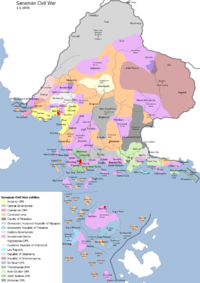Sanaman Civil War
| Sanaman Civil War | ||||||||
|---|---|---|---|---|---|---|---|---|
|
||||||||
| Belligerents | ||||||||
File:Sanama flag1.png Sanaman Federation of People's Republics
| Benacian Republic of Amarr Highpass and Sanilla
|
|||||||
| Commanders and leaders | ||||||||
| Strength | ||||||||
| 550,000 regular forces (V.1698) | 875,000 militia and revolutionary fighters (V.1698) | 175,000 Vanguards | ||||||
| Casualties and losses | ||||||||
| 4 Army soldiers | 56 militia members | 1 dog | ||||||
The Rice Riots of 1697 transitioned into the Sanaman Civil War in Puwha Kawlapali (IV) 1698 following the Malliki Tosha Plaza Massacre and a general breakdown of the government's ability to maintain public order, leading to the national government losing effective control over large parts of the country, leaving large swaths of both urban and rural territory in the hands of various armed militias, most notably those aligned with the Peoples' Front and those aligned with the Democratic Humanist Party.
Background
Events
IV.1698
The Rice Riots transitioned into the civil war in IV.1698, with Peoples' Front and Democratic Humanist Party militias forming and taking over large areas of Sanama, with the stated intent of guaranteeing public safety and order. The dominant party in the PF, the Sanaman Liberation Front (revolutionary) changes name to the Sanamati Democratic Party (Tatawal Koslhen Sharamyaya Sanamati), with "Sanamati" being a neologism meaning "Sanaman person" in the wider sense of a citizen of the Sanaman state. At the same time, the TKSS assumes supreme guidanceship over the Peoples' Front, with the other parties becoming entities within the wider TKSS. The TKSS also establishes several democratic people's republics across Sanama to organise the struggle against the government and other militias, while providing services and a governing framework for the areas under its control.
